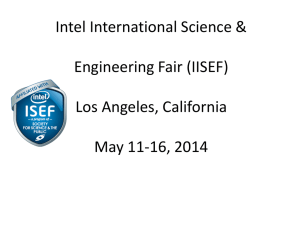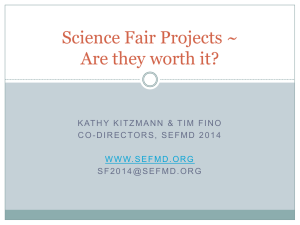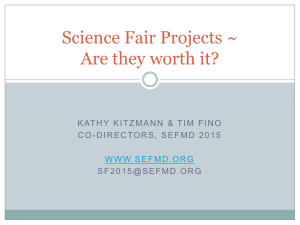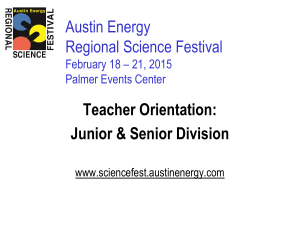Coriell 2012 Science Fair - Coriell Institute for Medical Research
advertisement
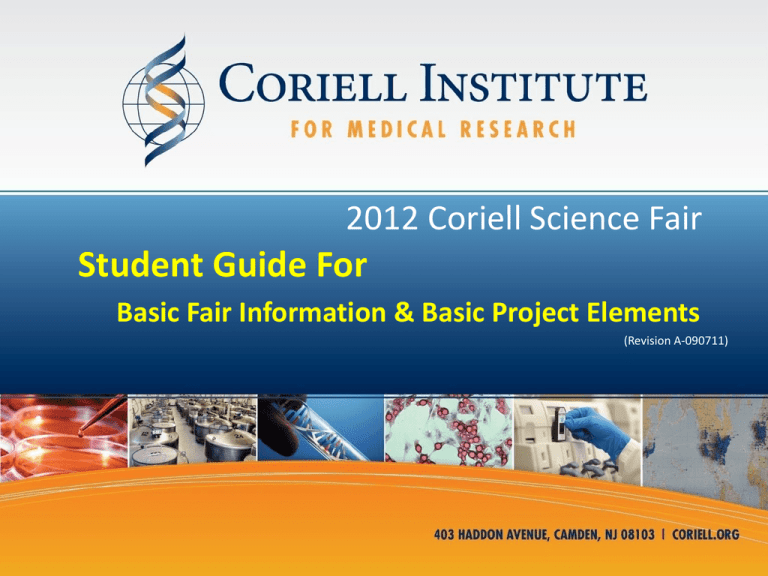
2012 Coriell Science Fair Student Guide For Basic Fair Information & Basic Project Elements (Revision A-090711) Who is Eligible to Participate 1. Students in 6th through 12th grades • Individual Projects • • • Grades 9, 10, 11 & 12 participate separately at each grade level Grades 6, 7 & 8 participate together as a single 6th-8th grade level Team Projects • • • Teams are limited to 2-3 students/team Students in grade 6,7 & 8 participate as a single 6th-8th team level Students in grades 9,10,11 & 12 participate as a single 9th-12th team level 2. Attend school in Burlington, Camden or Gloucester Co., New Jersey 3. Regular or Home-school students 4. If your school does not participate: Students with adult sponsors may participate 5. If your school or organization has a science fair: Your school or organization decides who may participate How to Participate 1. Download ISEF Rules and Forms from Coriell Web http://www.coriell.org/education/science-fair/ 2. Read and understand the rules and requirements and paperwork thoroughly before beginning: See “Forms and Rules.ppt” for info on required supervision and forms 3. ALL projects must be approved by a parent/guardian (Approval Form 1B) BEFORE starting and ALL projects involving physical, biological, and chemical risks, human participants or vertebrate animals must ALSO be approved BEFORE starting by an SRC By Coriell Scientific Review Committee (SRC) OR & also if appropriate by a Regulated Institute or Industry SRC 4. Plan a project & submit with ISEF forms and Research Plan*, & Coriell Student Contact Form: Send COPIES, Keep ORIGINALS) A: To Coriell G Butler, Coriell Inst. 403 Haddon Ave, Camden 08103 Email gbutler@coriell .org or sciencefair@coriell.org Fax (856) 964-0254 attn Science Fair B: If done at a Regulated Institute/Industry (RI/I), to the RI/I AND** to Coriell **If done at RI/I (including work in summer), Coriell can approve or reject defacto • The research plan is a “what I plan to do and how I plan to do it” document written before work starts and submitted with paperwork for approval and risk assessment in contrast to the abstract which is a “what I did and what happened” document which is submitted after the project is done. How to Participate: Continued 5. Coriell or Regulated Inst SRC reviews projects and emails back: Approved (You may then begin project) Revisions Required (You must resubmit corrected paperwork ) Coriell will determine, based on type of correction if you: May NOT begin work before resubmitting May begin work before resubmitting If revised paperwork is approved you may begin If work was done or will be done and approved at a Regulated Institute, Coriell must also approve or acknowledge that approval 6. Do the research 7. Register: If you decide to come to Fair, submit Registration form to Coriell between Feb 1 and Feb 19 (form will be posted on web late Jan.) 8. • Submit abstract with registration form if project is complete • If project is not complete by registration deadline: • Send registration form before Feb 19 and • Send abstract before March 12, or bring to set-up day (March 16) • Both abstracts and registrations forms are required to enter Fair Set up is Friday March 16, Fair day is Saturday March 17 Competition Categories Behavioral & Social Biochemistry Botany Chemistry Computers Consumer Science (6th-8th grade only) Earth & Space Engineering Environmental Math Medicine & Health Microbiology Physics Zoology Teams 6th-8th and Teams 9th-12th (2-3 student /team limit) Five Basic Steps in Doing a Project 1. 2. 3. 4. 5. Plan the experiment and obtain approval Do the experiment and keep a daily journal Write a report Make an abstract (summary paragraph) Create a presentation board MAKE A HYPOTHESIS An educated guess of what will happen Should be reasonable, but not necessarily correct Crystals will be larger when evaporation is slower. (Hypothesis of Positive action) Red classroom wall color will make student test scores lower. (Hypothesis of Negative action) Soil temperature will not affect plant growth. (Hypothesis of No action) Choosing a Topic “What is the effect of __A__ variable on __B__ subject measured by __C__ when __D__ Students fill in the ABCD blanks from lists units is constant MEASURE SOMETHING Examples of variables to be measured Irrigation / drought More mass / less mass Angle of launch Sunlight / dark Color of light pH Temperature Type of substrate Kinds of measurements Length / height Color change Speed / velocity Temperature Time Mass Opinions on surveys Volume Use numbers if possible Constants Are things that stay the same because: You hold them constant so that only one variable is tested at a time: In this example if plant growth differences due to light or water etc. are being measured, keep all the plants the same kind Or Constants can also be physically invariant like: Light speed = 650 million mph Liquid Nitrogen is -196 C Variables 0 Are things you manipulate (Independent) And things that change in response (Dependent) 1 4 Manipulated (Independent): weight on car Observed (Dependent): distance traveled Controls Are things to which you compare your results Negative Control (untreated): In comparing which toothpaste works best it is: Brushing your teeth with water Positive Control (treated with something known to work very well): In determining which color light makes plants grow better it is: Sunlight “N”: Repeated Measurements N is the number of times you test something N should be 3 or more. Conclusions drawn from only one trial are usually incorrect. Why Repeat Experiments? Example of wrong conclusions due to not repeating experiments Which Rots Faster: Potatoes or Tomatoes ? If N=1 its incorrectly: Tomatoes, If N = 3 its correctly: Potatoes Trial 1 (N=1) Potatoes 8 Potatoes Trial 1 Trial 2 Trial 3 Average 8 6 4 6 days to rot Tomatoes 4 days to rot Tomatoes days to rot Incorrect Conclusion Tomatoes (N=3) 4 16 10 10 days to rot Better Conclusion Potatoes Tables, Graphs, and Photo Tips Your data shown in tables, graphs, and photos communicate the most about your project to the judges! A judge should be able to look at only your data (tables, graphs, and photos), your abstract your title and understand the project without reading anything else Common Table, Graph and Photograph Flaws Absent Title Unlabeled Axes (Axis titles or units of measurement missing) Absent Legends Absent credits for who took photos or source Helpful Graph Components N= Standard Error bars (statistics) Example of a Good Graph Effect of UV Filters on Plant Growth 6 Plant Mass (Gm) 5 No Filter (+ Ctrl) UV A Filter UV B Filter Dark (- Ctrl) N=6 4 3 2 1 0 0 7 Time (Days) 14 The Abstract When you have completed your project, write an abstract telling what you did and what happened. Keep it Short (250 words or less) Purpose : Why you did the experiment Procedure : How you did the experiment Result: What you found out Conclusions: What you learned from the experiment Where to Put Abstracts: Send one copy to Coriell: (Put your project title, full name and school on this copy only). Attach one copy to you poster (upper left corner preferred) (Do NOT put your last name or school on this copy) Make an additional dozen copies (also without last name or school) to place by your poster for judges to take to the deliberation session. The Poster Title Format in same order as a scientific paper Results Abstract (250 words) Methods Diagrams Introduction & Background Include diagrams & flow charts in methods Use 14-16 Point font to make it easy to read quickly Data Graphs, Photos Materials & Methods Judges have 5-10 min to read. Keep it short and to the point Discussion & Conclusions In discussion Include: Significance of results What you would do If it didn’t work Report Log Book Loose Abstracts for Judges (12) What you would do if you could continue the experiment Science Fair Display Rules Size limits: (30 inches deep, 4 feet wide, 9 feet tall from floor) No liquids (except water integral to a sealed apparatus) No sharps (no knives, scalpels, needles, glass, nails, etc.) Do not have anything or parts of anything that is or has ever been alive: Use Photos. Examples: No plants, animals, seeds, bones, teeth, bacterial or cell cultures, worms, fish, insects, etc. No human or animal food No chemicals or drugs No flames No photographs of surgeries No awards, medals, endorsements or advertisements The Interview • • • • Judges interview students after viewing projects with the students absent Each student will be interviewed by at least two judges, often simultaneously Students can also be interviewed by additional special awards judges Be prepared to do the following: – Give a brief overview of you project and answer questions » » » » » » » – • What made you select the problem – What was the background? What was your hypothesis? What kinds of methods did you use? What results did you get? What problems did you encounter, and how did you solve them? What conclusions did you draw. Why are your results important to advancing science, medicine or engineering? What would you do next if you continued the project and / or had additional resources? Offer a copy of your abstract for the judges to take back to the deliberation session What the judges are looking for? – Originality and Creativity » – Scientific Thought » – Understanding, recognizing limitations, considering what could be done next, sufficient data, reasonable interpretations Clarity of Communication » – Positive and negative controls, recognizing and controlling variables, repeats, appropriate methods Thoroughness » – Contribution to basic or applied research or advancement or improvement of design or technology Clear statement of hypothesis, well-labeled clear graphs, charts, diagrams, descriptions of methods Skill » Good experimental design, analysis of data, problem solving skills, age-appropriateness, appropriate level of mentor involvement Advancement • Who Qualifies for Advancement to DVSF: – – – – 1st and 2nd Place winners in each category for each grade 9th-12th 1st, 2nd, and 3rd Place winners for each category in the 6-8th grade group 1st, 2nd, and 3rd Place winners for (9th-12th ) teams (9-12 is one level) 1st, 2nd, and 3rd Place winners for (6th-8th ) teams (6-8 is one level) • What do I have to do if I am qualified to advance? – Coriell informs you that you are qualified at the awards ceremony – Coriell sends you paperwork to DVSF in advance if you qualified – You simply show up at DVSF • Delaware Valley Science Fair (DVSF): – Dates: Tuesday April 3rd to Thursday April 5th, 2012 – Location: Oaks, PA – More Information: http://www.drexel.edu/dvsf/ • International Science and Engineering Fair (ISEF) – DVSF advances it’s top 13 projects to ISEF – Location and Dates: Pittsburgh, PA, Sunday May 13 - Friday May 18, 2012 – More Information: http://www.societyforscience.org/isef/ Got Questions? • Contact Dr. Gary Butler, Coriell Institute Science Fair – (856) 757-9716 – gbutler@coriell.org Help with ISEF Forms Please download and review the PowerPoint or pdf: 2012 Forms and Rules Guide Guide for Successful Completion of ISEF Forms (And Getting Approval without Correction and Resubmission) Posted on Coriell’s Web: http://www.coriell.org/education/science-fair/ For assisting teachers, parents and students in understanding the ISEF rules and forms and for preparation of ISEF paperwork, improving their chances of getting approval for Coriell’s Fair, and ensuring paperwork is in order if the project is selected for advancement to DVSF or ISEF



